
St. Catharines is the most populous city in Canada's Niagara Region, the eighth largest urban area in the province of Ontario. As of 2017, St. Catharines has an area of 96.13 square kilometres (37.12 sq mi) and 140,370 residents. It lies in Southern Ontario, 51 kilometres (32 mi) south of Toronto across Lake Ontario, and is 19 kilometres (12 mi) inland from the international boundary with the United States along the Niagara River. It is the northern entrance of the Welland Canal. St. Catharines carries the official nickname "The Garden City" due to its 1,000 acres (4 km2) of parks, gardens, and trails.

Thorold is a city in Ontario, Canada, located on the Niagara Escarpment. It is also the seat of the Regional Municipality of Niagara. The Welland Canal passes through the city, featuring lock 7 and the Twin Flight Locks.

The Welland Canal is a ship canal in Ontario, Canada, and part of the St. Lawrence Seaway and Great Lakes Waterway. The canal traverses the Niagara Peninsula between Port Weller on Lake Ontario, and Port Colborne on Lake Erie, and was erected because the Niagara River—the only natural waterway connecting the lakes—was unnavigable due to Niagara Falls. The Welland Canal enables ships to ascend and descend the Niagara Escarpment, and has followed four different routes since it opened.
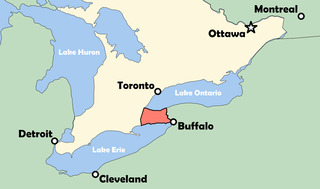
The Niagara Peninsula is an area of land lying between the southwestern shore of Lake Ontario and the northeastern shore of Lake Erie, in Ontario, Canada. Technically an isthmus rather than a peninsula, it stretches from the Niagara River in the east to Hamilton, Ontario, in the west. The peninsula is located in the Golden Horseshoe region of Southern Ontario, and has a population of roughly 1,000,000 residents. The region directly across the Niagara River and Lake Erie in New York State is known as the Niagara Frontier.

The Thorold Tunnel is an underwater tunnel in Thorold, Ontario, Canada carrying Highway 58 underneath the Welland Canal. Built between 1965 and 1967, the tunnel is 840 metres in length and consists of two separate tubes each containing two lanes of traffic. The westbound tube has a sidewalk for pedestrians.

St. Catharines is a federal electoral district in the Niagara Region of Ontario, Canada, that has been represented in the House of Commons of Canada since 1968.

Niagara Centre is a federal electoral district in the Niagara Region of Ontario that has been represented in the House of Commons of Canada from 1867 to 1988 and since 1997.

Port Dalhousie is a community in St. Catharines, Ontario, Canada. Known for its waterfront appeal, it is home to the Royal Canadian Henley Regatta and is historically significant as the terminus for the first three routes of the Welland Canal, built in 1820, 1845 and 1889.
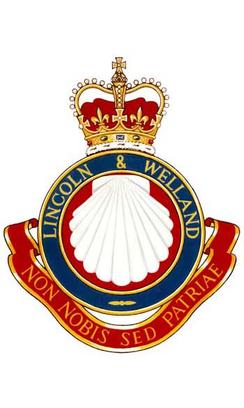
The Lincoln and Welland Regiment is a Primary Reserve infantry regiment of the Canadian Army based in St. Catharines, Ontario.
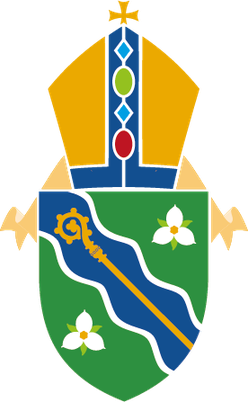
The Diocese of Niagara is one of thirty regional divisions in the Anglican Church of Canada. The see city of the diocese is Hamilton, with the bishop's cathedra located at Christ's Church Cathedral on James Street North. Located within the ecclesiastical province of Ontario, it borders the Dioceses of Huron and Toronto. The area enclosed by the Diocese of Niagara includes much of the Golden Horseshoe, and moves north to include Erin and Orangeville as far as Shelburne. Moving sharply south, the boundary includes Mount Forest and widens, south-westerly to include Elora and Guelph. Skirting Brantford and the Territory of the Six Nations Confederacy, the line then travels, again, south-westerly to Jarvis and Lake Erie to include the entire Niagara Peninsula. Major urban centres within its borders are St. Catharines, Niagara Falls, Hamilton, Guelph, Oakville, Milton, Burlington, and Orangeville.

The Welland House Hotel was a historic building located on 26-30 Ontario Street in Downtown St. Catharines, Ontario, Canada. The hotel spa resort was one of many in Upper Canada during the Victorian era. It closed in 1993. As of 2020, the site was in the process of being designated as a heritage site to prevent future demolition. Its last use was as a student residence, and then sat vacant. On July 12, 2021; it was destroyed in an early morning fire.

Downtown St. Catharines is the central business district of St. Catharines, Ontario, Canada. It is defined by the city as the area between Highway 406 on the west and south, Geneva Street on the east until it reaches St. Paul Street then Welland Avenue north until it meets Niagara Street.
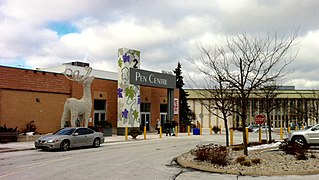
The Pen Centre is the largest shopping mall in the Niagara Region, located in St. Catharines, Ontario, Canada.
Welland Transit was a public transportation agency in Welland, Ontario, Canada from 1977 to 2022. Upon its inception in 1973 the bus service was operated by a private company, known as "Metro Niagara Transit," funded by the city of Welland, which assumed full operation of the transit system in 1977. On January 1, 2023, it was merged with St. Catharines Transit and Niagara Falls Transit to form Niagara Region Transit.
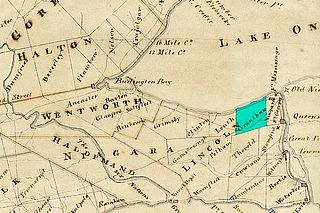
Grantham Township is a former incorporated and now geographic township on the Niagara Peninsula in Upper Canada, later Ontario.
The St. Catharines General Hospital was a general hospital established in 1865 in St. Catharines, Ontario, Canada, serving the Niagara Region. First established as a general and marine cottage hospital, it moved to Queenston Street in 1870. The hospital closed on March 24, 2013 after the new Niagara Health System St. Catharines site opened on Fourth Avenue.

Morningstar Mill is a 2.98-acre (1.21 ha) heritage site located in St. Catharines, Ontario, Canada. The site includes the Morningstar Mill, a sawmill, the home of the Morningstar family, a barn used for blacksmith demonstrations, and the Decew Falls gorge along the Niagara Escarpment. The site is operated by the volunteer group Friends of Morningstar Mill and owned by the City of St. Catharines. The gristmill was restored to working condition in 1992.
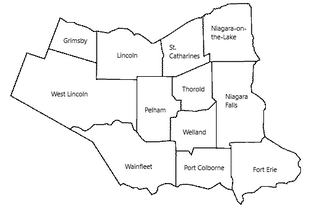
Elections were held in the Niagara Region of Ontario on October 24, 2022, in conjunction with municipal elections across the province.

The St. Catharines Public Library is a public library system that provides service to residents of St. Catharines, Ontario. The library has four branches: Central, Merritt, Port Dalhousie and Dr. Huq. Materials available for loan include books, films, musical instruments, and video games. As of September 2024, residents from Niagara Falls, Niagara-on-the-Lake, Port Colborne, Thorold, Wainfleet, and Welland could borrow items from the library.

The Grape and Wine Festival is an annual event that takes place in St. Catharines, Ontario, Canada, each September, with various activities. The festival starts and concludes with parades.


















